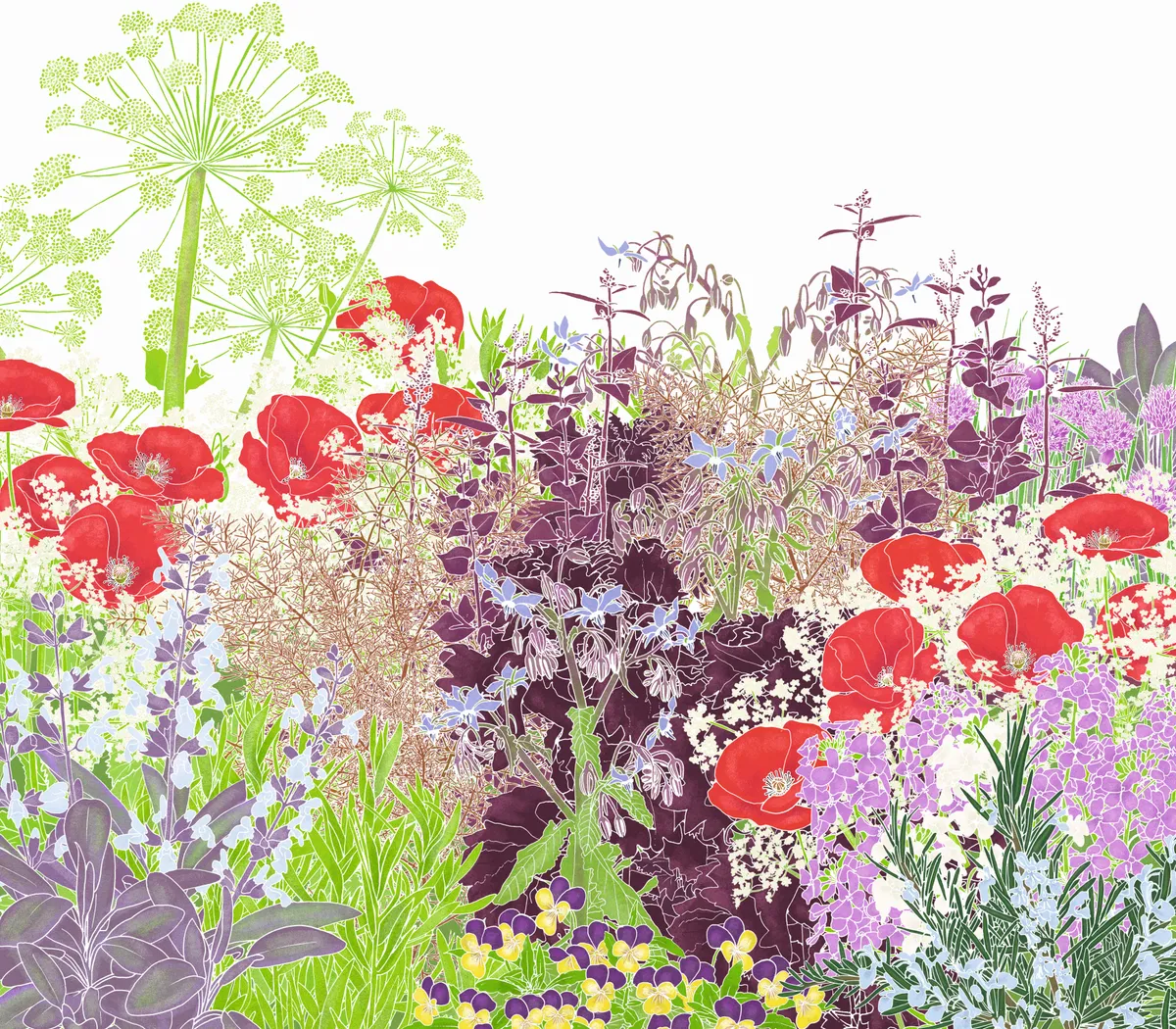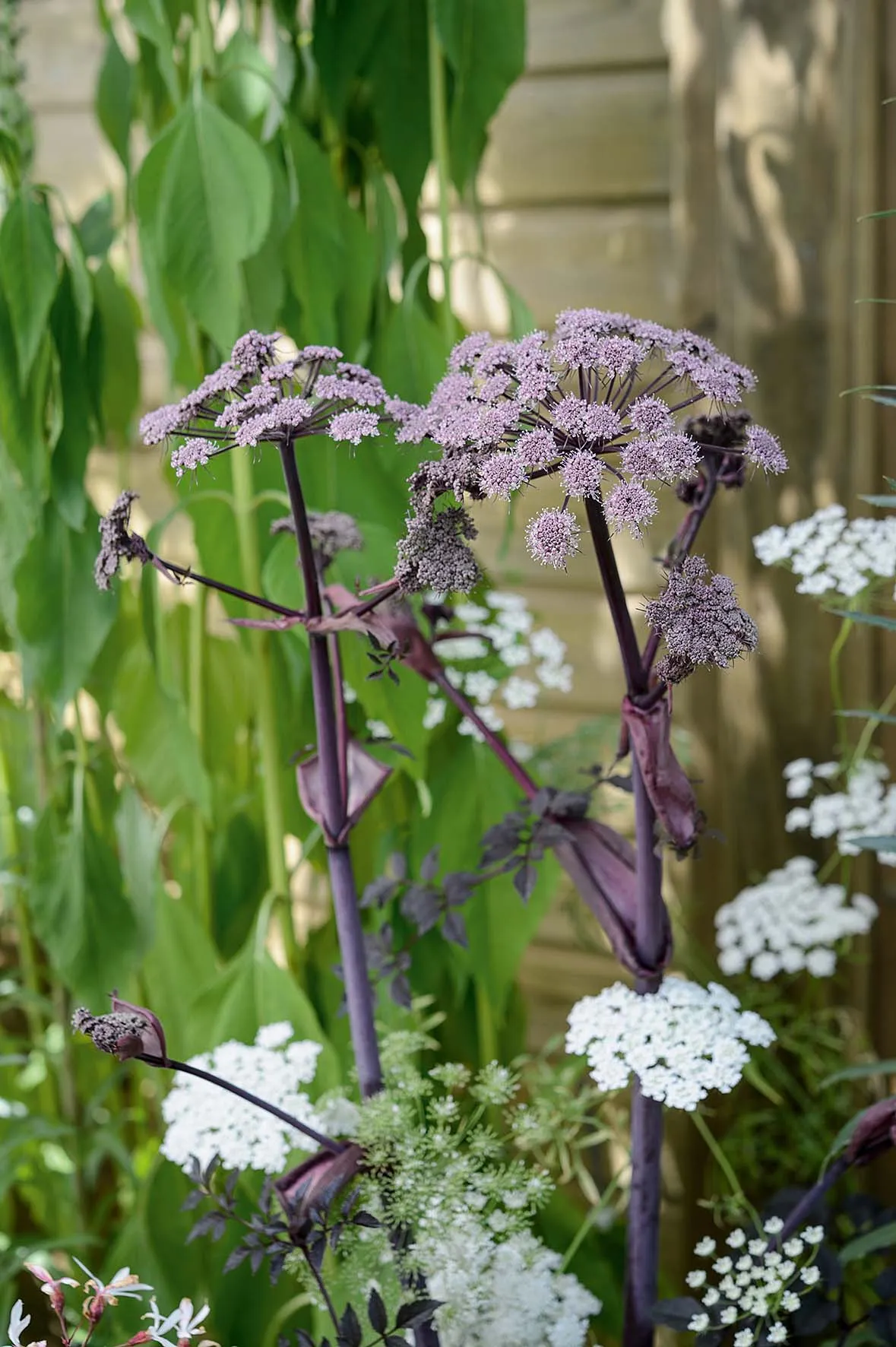Herbs, in my opinion are the most glorious plants – they look good, smell good, taste good and do you good. They are totally practical and simply the best thing to grow for anyone who wishes to use and enjoy plants.
This small border, measuring 1.25m by 2.5m, could be easily adapted to a raised bed. I have chosen herbs that are edible and either strongly scented or of striking colour. Using herbs with strong colours, such as the purple shiso, not only acts as a focal point but also enhances any neighbouring green foliage, making it seem greener.
I’ve been careful to include contrasting textures in both leaf and flower. There’s a balance in the ratio of annuals to perennials, too; this gives perennials room to spread in the following season.
This garden also has height. The tallest plant, the angelica, can easily reach 2.5m in its second or third year of growth, but when grown in a container or a raised bed the average height is 1.5m. It adds stature and, underplanted with caraway and poppies, makes a perfect combination. (Angelica is monocarpic, which means that it is not simply biennial, but can live for three to four years before it flowers, sets seed and dies.)
How to make a herb garden
Click the link below to download a PDF of the border plan and planting details

How to create your herb border
Plants included:
Angelica archangelica
Carum carvi
Papaver rhoeas
Perilla frutescens var. purpurascens
Borago officinalis
Atriplex hortensis var. rubra
Allium schoenoprasum
Foeniculum vulgare 'Purpureum'
Hesperis matronalis
Salvia officinalis 'Purpurascens'
Artemisia dracunculus
Viola tricolor
Rosmarinus officinalis Prostratus Group
First sow your seeds
It is important to sow angelica seeds fresh in late summer; they should then germinate within three weeks. These seedlings can be wintered in a cold frame before planting back in the border the following spring. If you save the seeds to sow in spring they will need a period of stratification (or cold treatment) to trigger germination.
The easiest way to do this is to place the seeds in a plastic bag mixed with some damp sand and pop it into the salad tray in your fridge. The seeds will germinate within two to three months. As soon as this happens, plant them in a small pot and grow on as normal; harden-off once rooted, then replant in the border.
One of the best recipes I know is for a jam made from the stems of a two-year-old angelica. As angelica is one of the ingredients used to give gin its flavour, this jam tastes like gin on toast.
To balance the garden I have placed the angelica in one corner and a prostrate rosemary directly opposite on the diagonal. This gives a flow from high to low and draws the eye through the garden.

I have balanced the blue flowers of the rosemary with the blue of the borage; being an annual this will need to be dug up in September. You won’t need to sow new seeds in the spring as borage happily self-seeds, but you will most probably need to thin them the following spring.
The front edge of any border is important as this, to my mind, is where you find the little gems. If you go for a walk in the country you will notice violas peeping out from underneath a hedge, or wild garlic growing in swathes alongside a babbling brook.
If your border or raised bed is accessible from all four sides, you will need to remember to balance the plants so that the aspect is pleasing from whichever angle you view it. I have used chives and heartsease as my ‘front of house’ plants. The chives look great in spring with their bright green shoots, which are followed in late spring to early summer with small globe heads of purple flowers made up of individual florets. These flowers have a sweet, onion flavour and are great added to salad and potato dishes. The little heartsease can be grown as an annual if required; its charming, three-coloured face is great added to fruit and green salads.
All the herbs chosen for this border like roughly the same conditions, and will happily adapt to being grown together. They can be grown in full sun or in some light shade. The ideal soil conditions would be a good loam that has been well fed with well-rotted kitchen waste. If, however, you decide to plant a raised bed, it is advisable to have the bottom of the bed lined with stones or rubble before adding the top soil, as this will aid drainage.
A border like this can bring you so much pleasure. It can transform your meals into a feast; add biodiversity to the insect and bird life in your garden; and look and smell beautiful, especially on a warm summer’s evening.
Where to buy
- Jekka’s Herb Farm Shellards Lane, Alveston, Bristol BS35 3SY. Seeds only. Also runs open days and courses.
- Hooksgreen Herbs (mail order)
- The Cottage Herbery This nursery, near Tenbury Wells in Worcestershire, is not open to the public but plants may be pre-ordered and collected from there.